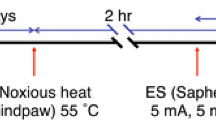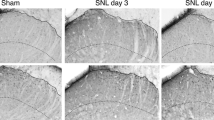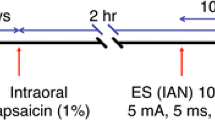Abstract
The number of c-Fos protein-like immunoreactive (c-Fos-IR) neurons in the spinal dorsal horn evoked by noxious stimulation was previously shown to be increased following peripheral nerve injury, and this increase was proposed to reflect the neuropathic pain state. The aim of this study was to investigate whether anomalous convergent primary afferent input to spinal dorsal horn neurons contributed to nerve injury-induced c-Fos hyperinducibility. Double immunofluorescence labeling for c-Fos and phosphorylated extracellular signal-regulated kinase (p-ERK) was performed to detect convergent synaptic input from different branches of the sciatic nerve after injury to the tibial nerve. c-Fos expression and the phosphorylation of ERK were induced by noxious heat stimulation of the hindpaw and also by electrical stimulation (ES) of the injured tibial nerve, respectively. The number of c-Fos-IR neurons was significantly decreased 3 days after the injury. However, the number of c-Fos-IR neurons returned to the control level 14 days after the injury. P-ERK immunoreactive (p-ERK-IR) neurons were induced in the central terminal field of the tibial nerve by ES of the tibial nerve. The topographic distribution pattern and number of such p-ERK-IR neurons remained unchanged after the nerve injury. The time course of changes in the number of double-labeled neurons, that presumably received convergent primary afferent input, showed a pattern similar to that of c-Fos-IR neurons after the injury. These results indicate that convergent primary nociceptive input through neighboring intact nerves may contribute to c-Fos hyperinducibility in the spinal dorsal horn.




Similar content being viewed by others
Abbreviations
- ANOVA:
-
Analysis of variance
- CNS:
-
Central nervous system
- ES:
-
Electrical stimulation
- c-Fos-IR:
-
c-Fos protein-like immunoreactive
- MAPK:
-
Mitogen-activated protein kinase
- p-ERK:
-
Phosphorylated extracellular signal-regulated kinase
- p-ERK-IR:
-
p-ERK immunoreactive
References
Devor M, Wall PD (1978) Reorganisation of spinal cord sensory map after peripheral nerve injury. Nature 276(5683):75–76
Hylden JL, Nahin RL, Dubner R (1987) Altered responses of nociceptive cat lamina I spinal dorsal horn neurons after chronic sciatic neuroma formation. Brain Res 411(2):341–350
Lisney SJ (1983) Changes in the somatotopic organization of the cat lumbar spinal cord following peripheral nerve transection and regeneration. Brain Res 259(1):31–39
Markus H, Pomeranz B, Krushelnycky D (1984) Spread of saphenous somatotopic projection map in spinal cord and hypersensitivity of the foot after chronic sciatic denervation in adult rat. Brain Res 296(1):27–39
Sugimoto T, Ichikawa H, Hijiya H, Mitani S, Nakago T (1993) c-Fos expression by dorsal horn neurons chronically deafferented by peripheral nerve section in response to spared, somatotopically inappropriate nociceptive primary input. Brain Res 621(1):161–166
Nomura H, Ogawa A, Tashiro A, Morimoto T, Hu JW, Iwata K (2002) Induction of Fos protein-like immunoreactivity in the trigeminal spinal nucleus caudalis and upper cervical cord following noxious and non-noxious mechanical stimulation of the whisker pad of the rat with an inferior alveolar nerve transection. Pain 95(3):225–238
Fujisawa N, Terayama R, Yamaguchi D, Omura S, Yamashiro T, Sugimoto T (2012) Fos protein-like immunoreactive neurons induced by electrical stimulation in the trigeminal sensory nuclear complex of rats with chronically injured peripheral nerve. Exp Brain Res 219(2):191–201. doi:10.1007/s00221-012-3078-8
Ji RR, Kohno T, Moore KA, Woolf CJ (2003) Central sensitization and LTP: Do pain and memory share similar mechanisms? Trends Neurosci 26(12):696–705
Ji RR, Woolf CJ (2001) Neuronal plasticity and signal transduction in nociceptive neurons: implications for the initiation and maintenance of pathological pain. Neurobiol Dis 8(1):1–10. doi:10.1006/nbdi.2000.0360
Ji RR, Baba H, Brenner GJ, Woolf CJ (1999) Nociceptive-specific activation of ERK in spinal neurons contributes to pain hypersensitivity. Nat Neurosci 2(12):1114–1119. doi:10.1038/16040
Noma N, Tsuboi Y, Kondo M, Matsumoto M, Sessle BJ, Kitagawa J, Saito K, Iwata K (2008) Organization of pERK-immunoreactive cells in trigeminal spinal nucleus caudalis and upper cervical cord following capsaicin injection into oral and craniofacial regions in rats. J Comp Neurol 507(3):1428–1440. doi:10.1002/cne.21620
Shimizu K, Asano M, Kitagawa J, Ogiso B, Ren K, Oki H, Matsumoto M, Iwata K (2006) Phosphorylation of extracellular signal-regulated kinase in medullary and upper cervical cord neurons following noxious tooth pulp stimulation. Brain Res 1072(1):99–109. doi:10.1016/j.brainres.2005.12.040
Devor M, Govrin-Lippmann R (1983) Axoplasmic transport block reduces ectopic impulse generation in injured peripheral nerves. Pain 16(1):73–85
Hughes AS, Averill S, King VR, Molander C, Shortland PJ (2008) Neurochemical characterization of neuronal populations expressing protein kinase C gamma isoform in the spinal cord and gracile nucleus of the rat. Neuroscience 153(2):507–517. doi:10.1016/j.neuroscience.2008.01.082
Molander C, Hongpaisan J, Grant G (1992) Changing pattern of c-Fos expression in spinal cord neurons after electrical stimulation of the chronically injured sciatic nerve in the rat. Neuroscience 50(1):223–236
Shortland P, Molander C (1998) The time-course of abeta-evoked c-Fos expression in neurons of the dorsal horn and gracile nucleus after peripheral nerve injury. Brain Res 810(1–2):288–293
Tokunaga A, Kondo E, Fukuoka T, Miki K, Dai Y, Tsujino H, Noguchi K (1999) Excitability of spinal cord and gracile nucleus neurons in rats with chronically chronically injured sciatic nerve examined by c-Fos expression. Brain Res 847(2):321–331
Swett JE, Woolf CJ (1985) The somatotopic organization of primary afferent terminals in the superficial laminae of the dorsal horn of the rat spinal cord. J Comp Neurol 231(1):66–77. doi:10.1002/cne.902310106
Strassman AM, Vos BP (1993) Somatotopic and laminar organization of fos-like immunoreactivity in the medullary and upper cervical dorsal horn induced by noxious facial stimulation in the rat. J Comp Neurol 331(4):495–516
Strassman AM, Vos BP, Mineta Y, Naderi S, Borsook D, Burstein R (1993) Fos-like immunoreactivity in the superficial medullary dorsal horn induced by noxious and innocuous thermal stimulation of facial skin in the rat. J Neurophysiol 70(5):1811–1821
Bullitt E (1990) Expression of c-Fos-like protein as a marker for neuronal activity following noxious stimulation in the rat. J Comp Neurol 296(4):517–530
Hunt SP, Pini A, Evan G (1987) Induction of c-Fos-like protein in spinal cord neurons following sensory stimulation. Nature 328(6131):632–634
Terayama R, Nagamatsu N, Ikeda T, Nakamura T, Rahman OI, Sakoda S, Shiba R, Nishimori T (1997) Differential expression of Fos protein after transection of the rat infraorbital nerve in the trigeminal nucleus caudalis. Brain Res 768(1–2):135–146
Yamaguchi D, Terayama R, Omura S, Tsuchiya H, Sato T, Ichikawa H, Sugimoto T (2014) Effect of adenosine A1 receptor agonist on the enhanced excitability of spinal dorsal horn neurons after peripheral nerve injury. Int J Neurosci 124(3):213–222. doi:10.3109/00207454.2013.842566
Dai Y, Iwata K, Fukuoka T, Kondo E, Tokunaga A, Yamanaka H, Tachibana T, Liu Y, Noguchi K (2002) Phosphorylation of extracellular signal-regulated kinase in primary afferent neurons by noxious stimuli and its involvement in peripheral sensitization. J Neurosci 22(17):7737–7745
Ji RR, Befort K, Brenner GJ, Woolf CJ (2002) ERK MAP kinase activation in superficial spinal cord neurons induces prodynorphin and NK-1 upregulation and contributes to persistent inflammatory pain hypersensitivity. J Neurosci 22(2):478–485
Liu Y, Obata K, Yamanaka H, Dai Y, Fukuoka T, Tokunaga A, Noguchi K (2004) Activation of extracellular signal-regulated protein kinase in dorsal horn neurons in the rat neuropathic intermittent claudication model. Pain 109(1–2):64–72. doi:10.1016/j.pain.2004.01.010
Kawasaki Y, Kohno T, Zhuang ZY, Brenner GJ, Wang H, Van Der Meer C, Befort K, Woolf CJ, Ji RR (2004) Ionotropic and metabotropic receptors, protein kinase A, protein kinase C, and Src contribute to C-fiber-induced ERK activation and cAMP response element-binding protein phosphorylation in dorsal horn neurons, leading to central sensitization. J Neurosci 24(38):8310–8321. doi:10.1523/jneurosci.2396-04.2004
Wang H, Dai Y, Fukuoka T, Yamanaka H, Obata K, Tokunaga A, Noguchi K (2004) Enhancement of stimulation-induced ERK activation in the spinal dorsal horn and gracile nucleus neurons in rats with peripheral nerve injury. Eur J Neurosci 19(4):884–890
Sugimoto T, Hara T, Shirai H, Abe T, Ichikawa H, Sato T (1994) c-Fos induction in the subnucleus caudalis following noxious mechanical stimulation of the oral mucous membrane. Exp Neurol 129(2):251–256
Acknowledgments
This study was supported by a Grant-in-Aid for Scientific Research from the Japan Society for the Promotion of Science (24592764).
Conflict of interest
The authors do not have any conflict of interest.
Author information
Authors and Affiliations
Corresponding author
Rights and permissions
About this article
Cite this article
Terayama, R., Kishimoto, N., Yamamoto, Y. et al. Convergent Nociceptive Input to Spinal Dorsal Horn Neurons After Peripheral Nerve Injury. Neurochem Res 40, 438–445 (2015). https://doi.org/10.1007/s11064-014-1484-y
Received:
Revised:
Accepted:
Published:
Issue Date:
DOI: https://doi.org/10.1007/s11064-014-1484-y




